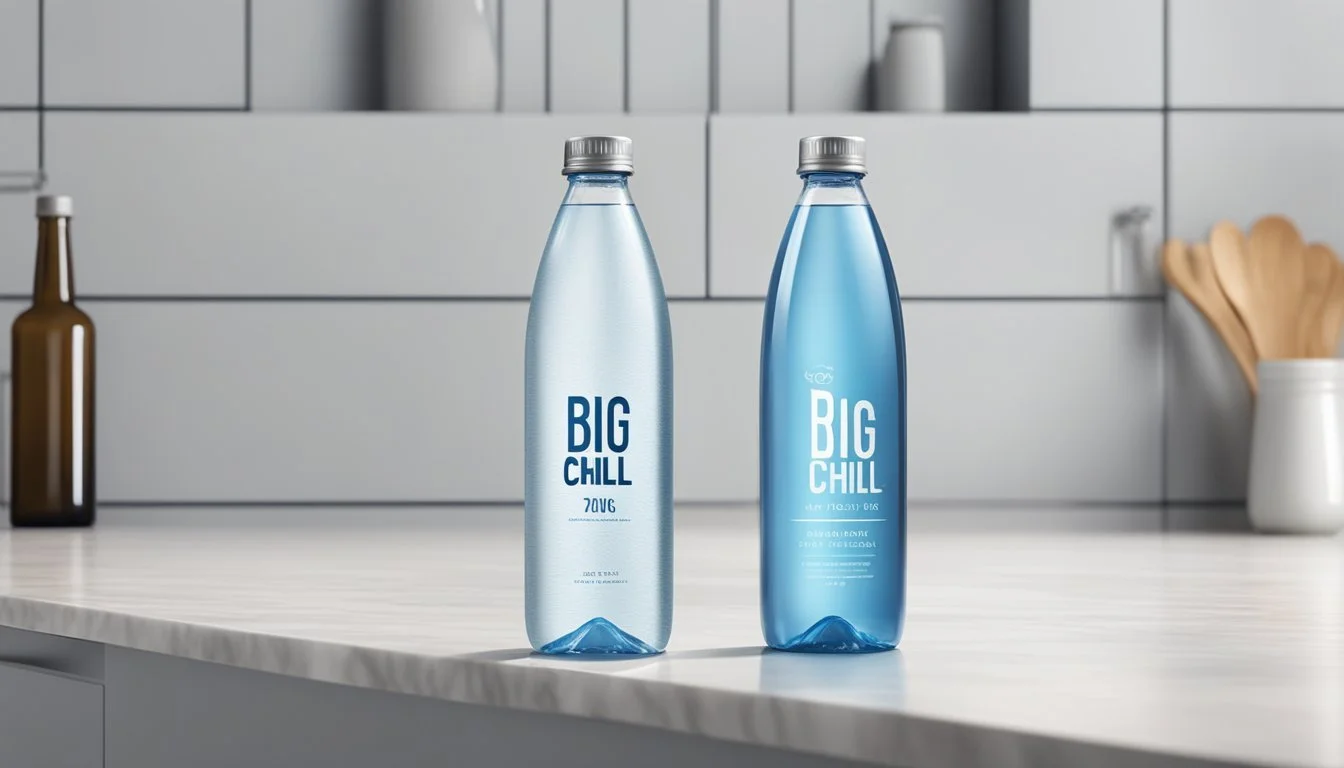Big Chill vs. Open Water
Bottled Water Showdown
When selecting bottled water, the debate between Big Chill and Open Water often arises. Big Chill, distributed by CVS, is a purified water that has been described as neutral in taste, making it a consistent and reliable option for those looking to stay hydrated without any frills. It's designed for easy access and purity, a simple choice for everyday hydration.
Open Water, on the other hand, comes in aluminum cans, which positions itself as an environmentally friendly alternative to traditional plastic bottles. This brand appeals not only to those concerned with hydration but also to consumers conscious of their ecological footprint. If sustainability is a primary concern, Open Water may be the better choice, but Big Chill stands out for its wide availability and neutral taste.
Both options serve different needs, with Big Chill catering to those who prioritize clean, basic hydration, and Open Water appealing to eco-conscious consumers. The choice between these two bottled waters often boils down to personal preference and values, making it essential to weigh the benefits of each to determine which one aligns best with your lifestyle and hydration needs.
Understanding Water Basics
Understanding the basics of water sources, composition, and safety regulations is crucial for consumers. This knowledge helps in making informed choices between different types of bottled water and tap water.
Sources of Water: From Tap to Bottle
Bottled Water Sources: About 75% of bottled water comes from natural sources like springs and wells, which must be protected against contamination. The remaining 25% is derived from municipal tap water that undergoes further purification.
Tap Water Sources: Municipal water systems generally source water from rivers, lakes, and reservoirs. This water is treated extensively to meet safety standards set by the Environmental Protection Agency (EPA).
Alkaline and Mineral Waters: Alkaline water has added minerals to increase pH above 7, while mineral water contains naturally occurring minerals like magnesium, calcium, and potassium.
Composition and Quality of Water
Mineral Content: Minerals such as calcium, magnesium, and potassium are present in both tap and bottled water. These minerals can contribute to the water's taste and potential health benefits.
pH Levels: Pure water has a neutral pH of 7. Tap water's pH can vary but typically falls between 6.5 and 8.5. Bottled water may be marketed as alkaline if its pH is above 7. Higher pH water claims to neutralize acidity but lacks scientific consensus for added health benefits.
Contaminants: Common contaminants include lead, arsenic, and PFAS (forever chemicals), which can pose severe health risks such as cancer. Municipal tap water systems regularly test for these contaminants, and bottled water companies must meet stringent FDA standards.
Water Regulations and Safety
EPA Standards: The EPA regulates municipal water quality under the Safe Drinking Water Act. It sets maximum contaminant levels and requires regular testing and public reporting.
FDA Standards: Bottled water is regulated by the FDA, which mandates labeling and the safety of production plants. The water must meet standards similar to municipal water.
Private Wells: Water from private wells does not fall under EPA regulations. Owners must independently ensure their water's safety through regular testing for contaminants like bacteria and heavy metals.
Environmental and Health Groups: Organizations like the Environmental Working Group provide databases like the Tap Water Database, helping consumers understand their local water quality. They advocate for stronger regulations and better protection of drinking water sources.
Bottled Water Deep Dive
When comparing bottled water brands like Big Chill and Open Water, it's essential to understand the differences in brand characteristics, the contents of the water they provide, and the impact of their packaging options. Each of these aspects plays a crucial role in determining which brand may be the better choice for consumers.
Differences in Bottled Water Brands
Bottled water brands vary significantly in source, processing, and market positioning. Brands such as Fiji, Evian, and Acqua Panna often highlight their origin from natural springs, whereas brands like Dasani and Penta focus on purified water. Natural spring water brands tend to emphasize purity and mineral content.
Packaging types also differ, with popular brands offering options in plastic, glass, and even boxed water. This variety caters to consumer preferences regarding convenience and environmental impact. Premium brands like Mountain Valley and Icelandic Glacial often package in glass for a more upscale appeal and reduced plastic usage.
Analyzing Bottled Water Contents
Different brands of bottled water contain varying levels of minerals and electrolytes. For example, Fiji water is known for its high silica content, while Core Hydration boasts balanced pH levels near 7.4, close to the body’s natural pH.
Sparkling water brands like San Pellegrino and Liquid Death offer carbonated options, which some consumers prefer for taste and digestion benefits. While purified water brands use methods such as reverse osmosis and ozonation to ensure the absence of contaminants, they may lack the natural minerals found in spring water.
The Impact of Packaging
Packaging plays a significant role in the environmental footprint of bottled water. Plastic bottles are prevalent due to their lightweight and cost-effectiveness, but their production involves considerable energy and oil consumption. They also contribute to plastic waste, posing challenges for recycling.
Glass bottles, used by brands like Mountain Valley, are more environmentally friendly as they are reusable and have a lower environmental impact in terms of waste. Boxed water, adopted by brands like Boxed Water, offers an alternative that reduces reliance on plastic and promotes sustainability. However, both glass and boxed options tend to be more expensive than plastic.
In summary, assessing the differences in brands, contents, and packaging reveals a multifaceted decision for consumers when choosing bottled water.
Health and Consumption
When choosing between Big Chill and Open Water, knowing their health impacts and potential risks is crucial. This section will discuss their hydration benefits and any possible contaminants.
Hydration and Health Benefits
Big Chill and Open Water both offer several hydration benefits. They are excellent sources for maintaining daily fluid levels. Adequate hydration supports vital bodily functions such as kidney and liver operations.
Big Chill often includes electrolytes like magnesium, potassium, and calcium, which can be beneficial for athletes. These minerals aid muscle function and improve cellular balance. Open Water generally bases its offering on clean, crisp taste without emphasizing additional minerals.
Consumption-wise, bottled water is often free from contaminants like lead and arsenic due to stringent filtration processes. Both brands are comparable in this regard, making each a safe choice for daily hydration.
Risks and Contaminants
Despite rigorous treatment, bottled water can sometimes contain trace contaminants. Potential risks include bacteria, sodium, and PFAS. Some studies suggest these chemicals, over time, can lead to adverse health effects, including cancer.
It's essential to consider the sodium levels in bottled water, as excessive sodium intake can affect blood pressure. Bottled water is typically low in sodium compared to other drinks but varies by brand.
Both Big Chill and Open Water undergo extensive testing to minimize health risks, making them generally safe for most consumers. Parents should monitor water quality closely if offering it to children, focusing on brands known for higher safety standards.
Environmental and Economic Considerations
When comparing Big Chill and Open Water, it's essential to evaluate both the environmental footprint and the cost-effectiveness of each option to make an informed choice.
Assessing Environmental Footprint
The production and disposal of plastic bottles have significant environmental impacts. Plastic bottles from brands like Big Chill use large amounts of energy, contributing to high CO2 emissions. For instance, creating 50 oz of bottled water can release between 1.6 and 22 oz of CO2.
In contrast, Open Water opts for aluminum cans, which are generally more environmentally friendly. Aluminum recycling is more efficient and less energy-intensive. Reusable water bottles offer the most sustainable option, as they reduce the need for single-use plastics and minimize pollution.
Cost Analysis of Water Options
In terms of cost, bottled water can be quite expensive especially with premium brands like Big Chill. The price of bottled water often includes the cost of production, packaging, and transportation. On the other hand, Open Water's use of aluminum cans might incur different associated costs but comes off as more cost-effective in the long run due to the can's reusability potential.
Comparing these with tap water reveals a stark difference; tap water is inexpensive and has minimal associated costs beyond local taxes and utility charges. Therefore, while bottled options may offer convenience, reusable water bottles combined with tap water provide a much more economical solution.
Consumer Preferences and Behavior
Consumers often base their bottled water choices on taste and aesthetic appeal, and this is further influenced by marketing and social media trends.
Taste and Aesthetic Appeal
Taste is one of the primary factors influencing consumer preferences for bottled water. Many consumers participate in taste tests to compare brands like Aquafina and Big Chill. Unlike milk or soda, the subtle differences in taste can make or break a preference for a particular brand.
The water bottle's design also plays a role in consumer choice. Clear, sleek bottles often appeal more due to their visual appeal in both stores and on social media platforms. Moreover, factors like smell and mouthfeel contribute to consumer preferences, despite these being less frequently discussed than taste.
Influence of Marketing and Trends
Marketing strategies significantly influence consumer behavior. High-profile campaigns and endorsements propel brands like Open Water and Big Chill into the spotlight. Social media platforms amplify this effect by generating buzz and user-generated content around these products.
Trends like sustainability and health concerns also guide preferences. For instance, a rise in eco-friendly packaging appeals to environmentally-conscious consumers. The confusion between bottled water and other beverages like Gatorade or flavored water often emerges, impacting consumer perceptions and behavior.
Brand loyalty is further reinforced by marketing, as consumers tend to revisit brands they recognize and trust from advertisements.





